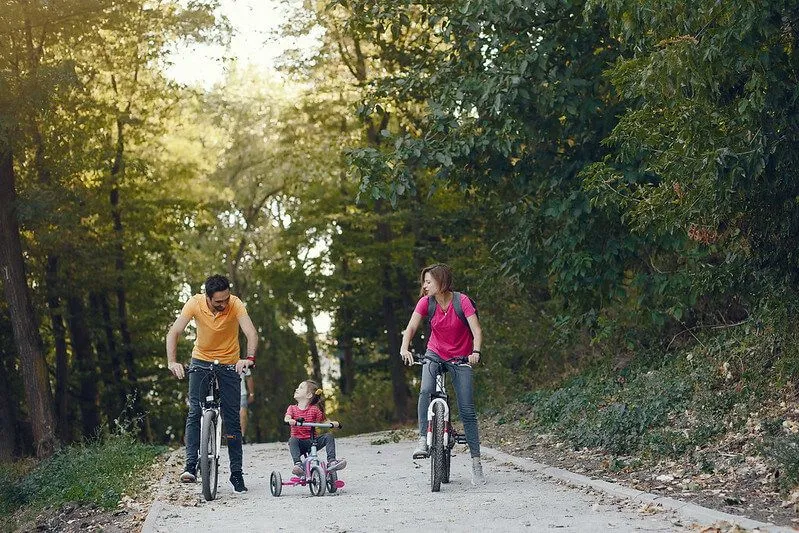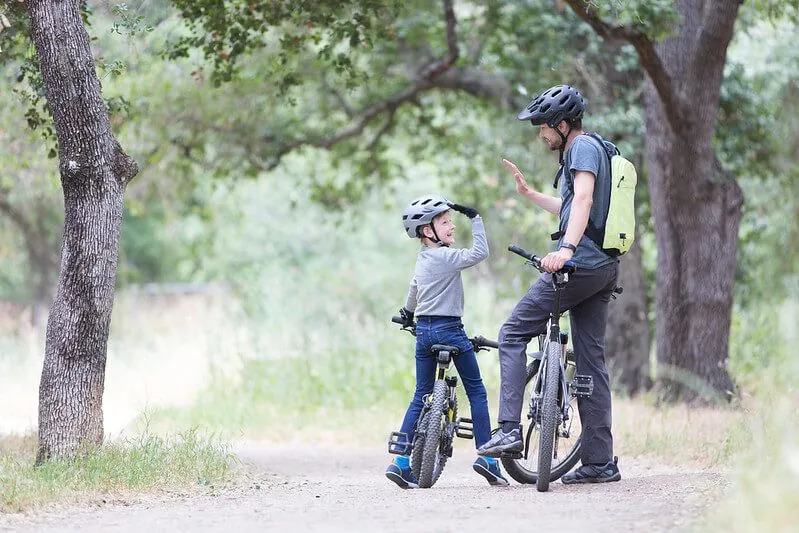FOR ALL AGES
Image: iStock
We all remember the exhilarating feeling of riding a bike for the first time without help: pure, fabulous, freedom.
Bike stabilisers are the prefect way for children to gain confidence with balance on a bike, but when's the right time to take them off? it's probably as nerve wracking for you as it is for your child!
Ultimately, riding a bike without stabilisers will help your child gain confidence and give them their first taste of independence. After a bit of practice, it will be, as they say, "easy as riding a bike".
Before you start, make sure your child has a good helmet and it's fitted correctly, meaning it's safe, secure and comfortable. Discuss the importance of safety and why a helmet must be worn every time they ride their bike.
To ensure a bike helmet is the right fit, visually, it should be level, with a gap of two fingers between the eyebrow and the helmet. The straps should be firm, but not too tight. If unsure, seek advise from your local bike shop.
Make sure the bike saddle is at the right height and that the breaks work.
It goes without saying that there will be a few bumps, scrapes and tantrums along the way, but, persevere. It will be worth it! When you teach a child to ride a bike, it can be one of the most exciting experiences you and your child will have together. It's a valuable life lesson.
Up to four-years-old, you may want to consider borrowing or buying a balance bike, it's a bike without pedals, but the child feels in control as they use their feet to push themselves along. The balance bike helps build up your child's leg muscles to help prepare themselves for their next next bigger bike. They're also significantly lighter, so easier to carry if your little one gets tired.
In a nut shell, bike stabilisers simply attach onto the hub of the rear wheel and support your child’s weight on each side, so they are supported on the bike and they can just get used to riding.
If your child is struggling to stay upright, confidence could be a issue. This is where a pair of bike stabilisers are invaluable as they allow your child to focus on building up their confidence while cycling.
Teaching a child to ride a bike with stabilisers on is easier, but, as your child gets older, they will see older children zipping around on bikes without them and they'll want to be just like the "cool kids" -- so use this as an insentive to shed the stabilisers.

Image: iStock
A set of Adie bike stabilisers (available from most bike shops) can be attached to most bikes, providing support. They are super easy to fit, you won’t need any additional tools and they can be adjusted depending on the size and shape of the bike.
If stabilisers are fitted correctly, the bike should rock a little from side to side. If the stabilisers are both touching the ground all the time, your child will find it harder to achieve natural balance and will be too dependent on them.
Once the stabilisers are off, pick a quiet, flat and safe area. Some children may feel nervous and self-conscience, surrounded by lots of people, so a back yard or cul-de-sac is perfect. It's better to avoid grass (although a softer landing) it's best to learn on a tarmac surface. When supporting your child at the beginning, hold on to their torso, not the bike handlebars, which would stop them steering. Obviously, avoid busy roads and practice in daylight with good visibility -- rain will not be your friend!
Children learn by watching, so if you show them your own bike, they can see how you get on and off and balance.

Concentration is vital when learning to ride a bike. You are your child's eyes and ears. But train them, too. Ask if they can see or hear anything they should avoid, helping them to anticipate and avoid potential dangers.
Many parents focus on getting the pedalling right from the start. However, the biggest challenge when it comes to safely learning to ride a bike is -- balance!
Don't ove- tire or stress out your child. Learning to ride a bike can be draining, physically and emotionally. They will get very tired, so rather than forcing them to do a set one hour a day, read their body language. If they are keen, it will ultimately make learning more pleasurable and efficient.
If your child falls off their bike, they will feel disheartened and will quickly lose confidence. You may also hear the words: " I HATE MY BIKE! I CAN'T DO IT!" Don't worry, this is normal. It's part of the process and probably one of the most difficult challenges they have ever faced. This is where you come in as an encouraging and reassuring parent. Agree, it is difficult, but with practice, they will ride a bike without stabilisers and the reward is huge.

Practise slow rides down small hills or slopes with their feet still on the pedals to see how your child balances. Once they get this right, the pedalling process should feel more natural.
Ironically, before you let them go, you have to make sure they can stop. Let your child practice using the breaks so they can safely stop.
So, the moment of truth, when you feel your child has gained enough confidence to go it alone, the stabilisers are off, you are supporting physically and emotionally, they feel confident and happy. Without saying anything, you just let go. Your child turns around to find, to their surprise, you're not there and they are riding alone without help. Eureka! Life lesson no.1, tick!
Read The Disclaimer
At Kidadl we pride ourselves on offering families original ideas to make the most of time spent together at home or out and about, wherever you are in the world. We strive to recommend the very best things that are suggested by our community and are things we would do ourselves - our aim is to be the trusted friend to parents.
We try our very best, but cannot guarantee perfection. We will always aim to give you accurate information at the date of publication - however, information does change, so it’s important you do your own research, double-check and make the decision that is right for your family.
Kidadl provides inspiration to entertain and educate your children. We recognise that not all activities and ideas are appropriate and suitable for all children and families or in all circumstances. Our recommended activities are based on age but these are a guide. We recommend that these ideas are used as inspiration, that ideas are undertaken with appropriate adult supervision, and that each adult uses their own discretion and knowledge of their children to consider the safety and suitability.
Kidadl cannot accept liability for the execution of these ideas, and parental supervision is advised at all times, as safety is paramount. Anyone using the information provided by Kidadl does so at their own risk and we can not accept liability if things go wrong.
Kidadl is independent and to make our service free to you the reader we are supported by advertising.
We hope you love our recommendations for products and services! What we suggest is selected independently by the Kidadl team. If you purchase using the buy now button we may earn a small commission. This does not influence our choices. Please note: prices are correct and items are available at the time the article was published.
Kidadl has a number of affiliate partners that we work with including Amazon. Please note that Kidadl is a participant in the Amazon Services LLC Associates Program, an affiliate advertising program designed to provide a means for sites to earn advertising fees by advertising and linking to amazon.
We also link to other websites, but are not responsible for their content.
Was this article helpful?



We’ll send you tons of inspiration to help you find a hidden gem in your local area or plan a big day out.



Check your inbox for your latest news from us. You have subscribed to:
Remember that you can always manage your preferences or unsubscribe through the link at the foot of each newsletter.